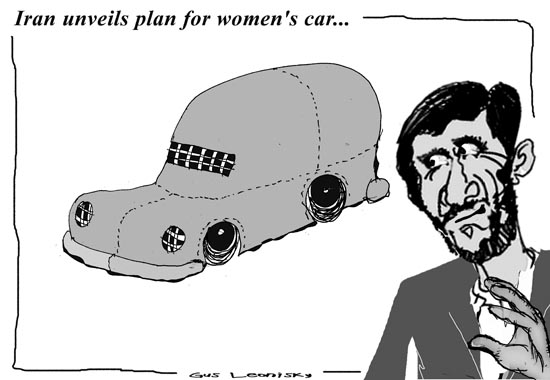Search
Recent comments
- chez bibi's....
16 hours 19 min ago - might is right.....
17 hours 26 min ago - revenge......
19 hours 3 min ago - on life support....
19 hours 12 min ago - moving on....
20 hours 23 sec ago - in finland....
20 hours 4 min ago - a mosaic....
20 hours 8 min ago - the mad house....
21 hours 52 min ago - RT metro....
1 day 38 min ago - EU piglets...
1 day 13 hours ago
Democracy Links
Member's Off-site Blogs
the value of innovation .....

Iranian women can drive cars but are not allowed to ride motorbikes.
Iran has announced plans for a new car designed specially for women.
Its features will include automatic transmission, parking and navigation aids and a jack for changing tyres without getting grease on your chador.
Iran's biggest car producer, Iran Khodro, says it will come in a range of feminine colours and interior designs.
Other features are proposed to make it easier for women when they are doing the family shopping or taking their children to school.
If that suggests a degree of sexist stereotyping in Iranian society, it is, just possibly, true.
Despite the fact that Iranian women now make up around 60% of university students, Iranian men have yet to absorb fully the message of equality.- By Gus Leonisky at 8 Oct 2008 - 10:00pm
- Gus Leonisky's blog
- Login or register to post comments
meanwhile, our despotic friends...
By NEIL MacFARQUHAR
RIYADH, Saudi Arabia — The government of Saudi Arabia moved swiftly to extinguish a budding protest movement of women claiming the right to drive, a campaign inspired by uprisings across the Arab world demanding new freedoms but at risk Monday of foundering.
Manal al-Sharif, 32, one of the campaign organizers, was detained Sunday in the eastern city of Dammam for up to five days on charges of disturbing public order and inciting public opinion by twice driving in a bid to press her cause, said her lawyer, Adnan al-Saleh.
Ms. Sharif was arrested after two much-publicized drives last week to highlight the Facebook and Twitter campaigns she helped organize to encourage women across Saudi Arabia to participate in a collective protest scheduled for June 17.
The campaigns, which had attracted thousands of supporters — more than 12,000 on the Facebook page — have been blocked in the kingdom. Ms. Sharif’s arrest was very likely intended to give others pause before participating in the protests in a country where a woman’s public reputation, including her ability to marry, can be badly damaged by an arrest.
“Usually they just make you sign a paper that you will not do it again and let you go,” said Wajiha Howeidar, who recorded Ms. Sharif while driving on Thursday. “They don’t want anybody to think that they can get away with something like that. It is a clear message that you cannot organize anything on Facebook. That is why she is in prison.”
The revolt that overthrew the Egyptian president, Hosni Mubarak, and similar efforts in the Middle East gained crucial momentum online.
Saudi Arabia is the only country that bars women from driving. But the topic remains a highly emotional issue in the kingdom, where women are also not allowed to vote, or even work without their husbands’, or fathers’, permission. For religious puritans, the ban on women driving is a sign that the government remains steadfast in the face of a Western onslaught on Saudi traditions. A political cartoon here once depicted car keys attached to a hand grenade.
http://www.nytimes.com/2011/05/24/world/middleeast/24saudi.html?_r=1&src=ISMR_HP_LO_MST_FB&pagewanted=print
see toon at top...
fashion design...
By Thomas Erdbrink, Published: December 26TEHRAN — In the Islamic republic of Iran, the law requires women to cover their hair and bodies in public. But how to do so remains up to them, and the result is persistent confusion in the streets.
Though leading Shiite Muslim clerics advise women to wear chadors — the traditional head-to-toe cloak, usually black — Iran’s urban fashionistas increasingly prefer tight-fitting coats and scant head scarves.
Now, President Mahmoud Ahmadinejad is stepping into the dispute. He wants to settle it by promoting government-approved apparel for women, garments intended to introduce an array of clothes that are “Islamic and beautiful” at the same time.
Hard-liners are not amused. They say that the new designs encourage “Western values.” But at a recent government-sponsored fashion show, young women and their mothers gazed approvingly at the plastic mannequins showcasing the new coats and scarves.
Shoukoufeh Arabpour, 23, coveted a velvet blue “manteau,” as women’s coats are called here, borrowing from the French word. The design was called “peacock” and clearly marked a world of difference from the black chador that Arabpour had wrapped around herself.
“I adore it,” said Arabpour, a student of fashion design. Around her, other women took photos of the 110 designs, which were entered in a competition for the best Islamic dress.
Followed by television cameras, a team of judges — mostly men — circled the halls, grading the coats on their functionality, design and “Islamic-ness.”
http://www.washingtonpost.com/world/middle_east/in-iran-a-battle-over-womens-fashions/2011/12/22/gIQAj0HVIP_print.html
see toon and story at top...